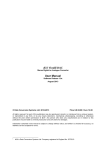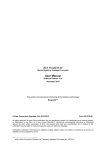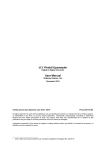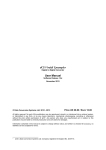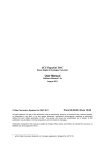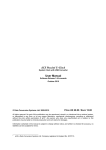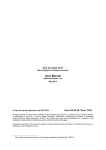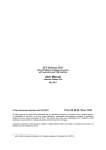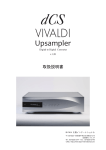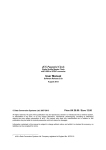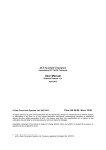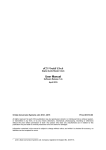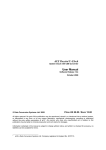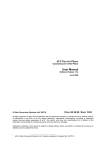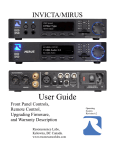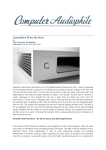Download "user manual"
Transcript
dCS Rossini Upsampling Network DAC User Manual Software Release 1.0x November 2015 This product incorporates the following dCS proprietary technology: Ring DAC™ © Data Conversion Systems Ltd. 2015 Price UK £10.00 All rights reserved. No part of this publication may be reproduced, stored in or introduced into a retrieval system, or transmitted in any form, or by any means (electronic, mechanical, photocopying, recording or otherwise) without the prior written permission of dCS 1 . Any person who does any unauthorised act in relation to this publication may be liable to criminal prosecution and civil claims for damages. F F Information contained in this manual is subject to change without notice, and whilst it is checked for accuracy, no liabilities can be accepted for errors. 1 dCS is Data Conversion Systems Ltd. Company registered in England No. 2072115. dCS Rossini Upsampling Network DAC User Manual Rossini DAC Manual v1_0x Page 2 Software Issue 1.0x November 2015 English version dCS Rossini Upsampling Network DAC User Manual Software Issue 1.0x November 2015 Contents Using the dCS Rossini DAC for the first time......................................................................................5 What’s in the box? Positioning the unit Condensation Safety Notice Made for iPhone® and iPad® Step-by-Step Guide Preliminaries STEP 1 – Connecting the analogue outputs Using a preamplifier Using a power amplifier directly Balanced Outputs STEP 2 – UPnP Network Connection Compatibility Basic set-up Playing music with AirPlay Using the Rossini DAC with Spotify Connect STEP 3 – Using the DAC’s PCM Inputs Connecting to a Dual AES Source Connecting to a Single AES or SPDIF source STEP 4 – Using the USB1 interface with a computer Compatibility Setting the USB Audio Class Loading the Windows driver for USB Class 2 Basic setup with a PC A word about Music Playing Software Selecting the Rossini DAC as your Audio Output device STEP 5 – Using the USB2 input STEP 6 – Clocking Using the Rossini Clock Using the Rossini DAC in Master Mode with a Transport Using the Rossini DAC and Clock with a Transport Further suggestions Renaming the digital inputs Renaming your Rossini Power Link 5 5 6 6 7 8 8 9 9 9 9 10 10 10 16 16 17 17 18 19 19 19 19 20 20 21 22 23 23 24 25 26 26 27 27 Front Panel ............................................................................................................................................28 Display – Network Renderer Display – DAC Mode Remote Control Receiver Control Modes Power Button Menu Button Filter Button Input button Mute Button Rotary Control 28 29 29 29 30 30 30 30 30 31 Rear Panel .............................................................................................................................................32 Analogue Outputs AES Digital Inputs SPDIF Digital Inputs USB Interfaces Word Clock Inputs and Output Network Interface IR Remote Receiver RS232 interface Mains inlet Label Rossini DAC Manual v1_0x Page 3 32 32 32 33 33 34 34 34 34 34 English version dCS Rossini Upsampling Network DAC User Manual Software Issue 1.0x November 2015 The Menu ...............................................................................................................................................35 Using the Menu INFORMATION Menu Unit Status Version Contact Update AUDIO SETTINGS Menu Phase Filter DSD Filter Ch Swap Balance UNIT SETTINGS Menu Sync Mode Output Level Dual AES USB Class Buffer Upsampling RS232 Mode CONFIGURATION Menu Settings Lock Save Configuration Restore Configuration Reset Input Names Factory Reset DISPLAY SETTINGS Menu Brightness Display On/Off Logo On/Off GENERATOR Menu Channel Check Phase Check Burn In 36 37 37 37 37 37 38 38 38 38 38 38 39 39 39 40 40 40 40 40 41 41 41 41 41 41 42 42 42 42 42 42 42 42 Specification .........................................................................................................................................43 Maintenance and Support....................................................................................................................45 Service and Maintenance Replacing a Blown Mains Fuse Cleaning the case Limited Warranty If you need more help Software History Software update 45 45 45 46 47 47 48 Index ......................................................................................................................................................49 Rossini DAC Manual v1_0x Page 4 English version dCS Rossini Upsampling Network DAC User Manual USING THE dCS ROSSINI DAC Software Issue 1.0x November 2015 FOR THE FIRST TIME Congratulations on purchasing your dCS Rossini DAC. Before using your unit, please read this section and the Step by Step Guide. This will enable you to set the unit up quickly and safely with your hi-fi system. From time to time, dCS will release updated software that you can install yourself using the Update feature in the menu or the Rossini App. Please check our web-site occasionally to see if new Rossini software is available, or consult your dealer. What’s in the box? Check that the box contains the following items: • • • • • • • dCS Rossini DAC Manual and Menu Guide Power cable Ethernet cable USB cable type A-B 2 spare fuses Spotify™ flyer Notify your dealer as soon as possible if anything is missing or damaged. We suggest that you retain the original packaging for possible future use. If this is not possible, replacement packaging can be ordered from dCS or our distributors. Details can be found on our web site at www.dcsltd.co.uk. H The Rossini DAC is intended to be controlled by the Rossini App over an ethernet network. A dCS Premium IR remote control is available as an optional extra. Positioning the unit For best sound quality, the units in the Rossini range are designed to be mounted on separate shelves of a rack, although they may be stacked directly on top of each other if this is absolutely necessary. Place each unit on a firm, vibration free base, allowing convenient connection to the other parts of your system. To prevent overheating, we recommend that you leave some free space around the unit to allow for ventilation. You can use the feet to level the unit. With all feet screwed fully home, the unit will sit level on a flat surface. If you need to do any levelling, you can unscrew any of the feet up to 3 complete turns, to give up to 3mm (1/8”) of height adjustment. Rossini DAC Manual v1_0x Page 5 English version dCS Rossini Upsampling Network DAC User Manual Software Issue 1.0x November 2015 Condensation If the DAC is cold and is moved into a warm room, condensation will form inside the unit. This interferes with normal operation. Remove the DAC from its packaging and let it stand for 1-2 hours, to allow it to reach room temperature and the condensation to evaporate. Safety Notice Your dCS Rossini DAC contains no user serviceable parts. DO NOT attempt to open the case as there are potentially dangerous voltages present inside. In the event of the unit developing a fault, please contact your dealer in the first instance. If you decide to remove safety covers for any reason, disconnect the power cable first. Note that removing covers voids the warranty. To maintain protection from electric shock, the unit MUST be connected to mains earth (ground) via the power cable. Also, unearthed systems do not give the best sonic performance. Protect the product from dripping or splashing liquids. Liquid-filled objects such as vases must not be placed on the product. This product is lead-free and complies with the RoHS directive. Before connecting the power cable to the unit for the first time, please check that it has been set to the correct operating voltage for your mains supply. The unit’s voltage setting is shown on the serial number label. If this does not match your local supply voltage, DO NOT attempt to use the unit. Contact your dealer to have the unit reset. Using the unit with the wrong mains setting for your local supply may result in serious damage to the unit and will invalidate the warranty. Do not attempt to reset the voltage yourself. We do not recommend the use of mains regenerators. However, if you do wish to use a mains regenerator with variable voltage and frequency, we recommend that you set the voltage to match your local voltage and the frequency to either 50Hz or 60Hz ONLY. ! Damage caused to your Rossini DAC by misuse of a mains regenerator or by a malfunctioning mains regenerator is not covered by the warranty. Disposal at end-of-life - the symbol indicates that this product should not be treated as normal household waste. It should be recycled, so please take it to an approved collection facility. Rossini DAC Manual v1_0x Page 6 English version dCS Rossini Upsampling Network DAC User Manual Software Issue 1.0x November 2015 Made for iPhone® and iPad® The Rossini DAC is compatible with the iPhone and iPad models illustrated below. Made for: “Made for iPod” and “Made for iPhone” mean that an electronic accessory has been designed to connect specifically to iPod or iPhone respectively and has been certified by the developer to meet Apple performance standards. Apple is not responsible for the operation of this device or its compliance with safety and regulatory standards. iPad®, iPhone, iPod and iPod touch® are trademarks of Apple Inc., registered in the U.S. and other countries. Rossini DAC Manual v1_0x Page 7 English version dCS Rossini Upsampling Network DAC User Manual Software Issue 1.0x November 2015 Step-by-Step Guide This section guides you through setting up the unit for basic operation. Preliminaries The Menu Guide sheet details the menu structure and describes the two most common set-ups. For digital interfaces, use with cables designed for digital audio: • for AES/EBU interfaces use 110Ω screened, twisted pair cables fitted with one male XLR connector and one female XLR connector. • for Word Clock or SPDIF BNC interfaces, use 75Ω coax cables fitted with BNC plugs. Word Clock interfaces require a simple DC-coupled connection. The interfaces may malfunction or not work at all if capacitor coupled cables or cables with built-in networks are used. • • • • for SPDIF RCA interfaces, use 75Ω coax cables fitted with RCA Phono plugs. for TOSLINK optical interfaces, use Toslink fibre-optic cables. for the Network interface, use an RJ45 Ethernet cable, such as that provided with the unit. for the USB1 interface, use a standard screened USB 2.0 cable fitted with one type ‘A’ connector and one type ‘B’ connector. The internal screen must be connected at both ends. For analogue outputs, use with screened cables of the correct type: • for balanced outputs, use screened, twisted pair cables fitted with one male XLR connector and one female XLR connector. • for unbalanced outputs, use coax cables fitted with RCA Phono plugs. Some “audiophile” cables have unusual grounding or screening arrangements, or do not have the correct characteristic impedance. If you have difficulty using such cables but the problems disappear when ordinary cables are substituted, please ask the cable manufacturer or your dealer for support. Connect the power cable supplied to the power inlet on the DAC’s rear panel, plug the other end into a convenient power outlet. ! Please do not use an excessively heavy or inflexible power cable as this may damage the power inlet connector. The cables supplied with the unit are “commercial grade”, because most owners will have their own “audiophile grade” cables or will prefer to make their own cable choices. Set the rocker switch near the mains inlet to the I position, press the Power button. Wait about 10 seconds while the DAC configures itself. If the unit is likely to be set in an unfamiliar state, you can run the Factory Reset routine by pressing the buttons in this sequence: Menu, ►, ►, ►, Menu, ◄, ◄, Menu. Wait a few seconds while the unit resets itself. Rossini DAC Manual v1_0x Page 8 English version dCS Rossini Upsampling Network DAC User Manual Software Issue 1.0x November 2015 STEP 1 – Connecting the analogue outputs Choose one of the following two sections: Using a preamplifier • Set the preamplifier volume control to a low level. • Connect either the balanced (XLR connectors) or unbalanced (RCA phono connectors) outputs on the DAC’s rear panel to matching line level inputs on your preamplifier (probably labelled CD or AUX). • Turn the DAC’s rotary control clockwise to set the Volume to maximum (- 0.0dB on the display). • Slowly increase the preamplifier volume until the music is at the right level. • If the preamplifier volume setting for a comfortable listening level is too high or too low, you may need to change the Output Level setting. • Press the buttons in this sequence: Menu, ►, ►, Menu, ►, Menu. Setting the Output Level to 6V can cause some preamplifiers to distort. For this reason, we recommend the 2V setting if a preamplifier is used. Using a power amplifier directly • Set the DAC’s Volume to around -40.0dB as shown on the display. • Connect either the balanced (XLR connectors) or unbalanced (RCA phono connectors) outputs on the DAC’s rear panel to matching inputs on your power amplifier. Switch on the power amplifier. • Turn the DAC’s rotary control slowly clockwise until the music is at the right level. • If the Volume setting for a comfortable listening level is higher than –10.0 or lower than –30.0, try changing the Output Level setting. • Press the buttons in this sequence: Menu, ►, ►, Menu, ►, Menu. Balanced Outputs The most common fault reported when using our balanced outputs is hiss, unstable levels and a thin sound on both channels. This is caused by connecting the DAC’s balanced output stage to an unbalanced input on an XLR connector with pin 3 left unconnected. This does not work correctly with a balanced and floating output stage – you must connect pin 3 to pin 1 (ground) to complete the signal path. Another possible cause of this fault (probably on one channel only) is a broken cable. ! Balanced or unbalanced Analogue outputs to pre- or power amplifier Figure 1 – Basic setup for the Rossini DAC The Rossini DAC has independent balanced and unbalanced output stages, you can connect them to different amplifiers if you wish. Rossini DAC Manual v1_0x Page 9 English version dCS Rossini Upsampling Network DAC User Manual Software Issue 1.0x November 2015 STEP 2 – UPnP Network Connection UPnP (Universal Plug and Play) is a set of protocols designed to allow consumer devices to interact over a network. The Rossini DAC complies with the UPnP AV protocol, enabling it to communicate with other non-dCS devices, provided they also comply with this protocol. A network streaming system is made up of three standard UPnP components: UPnP Control Point, UPnP Media Renderer and UPnP Media Server. A system may consist of one or more of each of these components. In such a system, all of the media (songs, tracks, videos etc) is stored on the server. This storage device can be a NAS or a Computer. The control point (e.g. a tablet or smart phone) requests the address of a particular item of media from the server (e.g. a NAS drive). It then passes this address to the renderer (e.g. a Rossini DAC) to play. The renderer directly retrieves the item from the specified address on the server, decodes and plays the media as it arrives over the network from the server. Enabling network streaming of audio using a Rossini DAC relies on the presence of standard network infrastructure in your system. A description of the network will not be discussed in this manual but at a minimum the following components are required for system setup: Router, Computer, Rossini DAC, NAS, Wireless access point (WAP), Wireless control point. Please note that Ethernet cables are required to connect the devices and the NAS must have UPnP media server software (e.g. Twonky, Asset, MinimServer) installed. If the UPnP control point is having problems seeing the UPnP media server or the UPnP media renderer, you might need to disable IGMP snooping in the router or enable UPnP discovery mode in the router or the NAS drive. The dCS Rossini App is a control point application that will allow users to view / select available renderers, view / select available media servers and browse / select / playback music via the Rossini DAC. The dCS Rossini App is currently available for iOS. At the time of writing, the iPhone / iPod Touch version of the app is available. Apps for iPad and Android tablets are in development. Compatibility The Rossini DAC and the App are compatible with: • iPhone 5 or later. • iPod Touch 5th generation. Rossini App version 1.0.0 has been tested with iOS8. Basic set-up • Connect the system as shown below. Router NAS Analogue outputs Figure 2 – Using a Rossini DAC with a NAS Rossini DAC Manual v1_0x Page 10 English version dCS Rossini Upsampling Network DAC User Manual • • • • • Software Issue 1.0x November 2015 For iPhone/iPod, download the dCS Rossini app from the App Store and install it. Connect the DAC’s Network interface to the Ethernet network. Connect the control device (e.g. iPhone) to the network. Launch the dCS Rossini App. The system will search for Rossini Players / DACs. Tap Configure to change the Rossini’s settings, get information about the unit or use the test features. Tap Preferences to optimise the unit for your use. • Tap the picture of the DAC to go to the Home page. • Tap UPnP to select a NAS on the same network. (Alternatively, tap USB/iPod to select a flash drive connected to the USB2 port.) • Tap on a server to select it. • Select the browsing method (Artist, Album, etc.). Rossini DAC Manual v1_0x Page 11 English version dCS Rossini Upsampling Network DAC User Manual • Navigate down to the track list. Software Issue 1.0x November 2015 • Choose either All Tracks to play the whole album or Selected Tracks and then tap on the tracks you want to play. • Tap one of the action buttons: Cancel the Queue and play now. Add to the start of the Queue. Add to the Queue after the current track. Add to the end of the Queue. Add to a Playlist. The DAC’s Network input is automatically selected when the track starts playing. • Tap the back icon if you want to return to the previous page. • Tap the Home icon if you want to return to the Home page. • Tap the Play icon at the bottom of the screen to see the track that is currently playing. Rossini DAC Manual v1_0x Page 12 English version dCS Rossini Upsampling Network DAC User Manual Software Issue 1.0x November 2015 • Current track: Shuffle tracks. Repeat track. Change phase. Adjust volume. • Set the volume slider as required, then click the white x to close the volume panel. Tap here to go to the Playlists page. Alternatively, go to the Home page and tap Playlists. Rossini DAC Manual v1_0x Page 13 English version dCS Rossini Upsampling Network DAC User Manual Tap on a list or the Play Queue to open it. Software Issue 1.0x November 2015 To delete a Playlist, swipe it to the left and tap Delete. Select a track and tap the Play icon to start playing it. Tap here to save the Play Queue as a new Playlist, type a name and tap OK. Tap this icon to start editing the open Play Queue or a Playlist. To change the track order, drag tracks to the new position. To delete tracks from a list, select them and then tap this icon. When you have finished editing the list, tap the highlighted edit icon again to de-select it. Rossini DAC Manual v1_0x Page 14 English version dCS Rossini Upsampling Network DAC User Manual Software Issue 1.0x November 2015 While browsing albums, artists or tracks, you can search for some text in the list. Tap on the Search icon – the keyboard will appear. Type the text you want to search for (or just part of it). If you have a large music library, the search may take some time. Please be patient and take care not to type a letter twice. When the matching entries are displayed, drag downwards in the list to close the keyboard. Select the track you want and either play it or add it to a playlist. Rossini DAC Manual v1_0x Page 15 English version dCS Rossini Upsampling Network DAC User Manual Software Issue 1.0x November 2015 Playing music with AirPlay When the DAC is connected to a network, music can be streamed from an Apple device via AirPlay to the DAC. When AirPlay is active, the DAC’s Network input is automatically selected. ! The lower Output Level settings are intended to prevent accidents when driving the amplifiers directly and AirPlay is in use, as the volume set by the sending device can be very high. Using the Rossini DAC with Spotify Connect Spotify lets you listen to millions of songs – the artists you love, the latest hits and discoveries just for you. If you are a Spotify user, you can control the DAC using your Spotify App. 1. Connect the DAC to the same Wi-Fi network as your phone, tablet or PC running the Spotify app. 2. Open the Spotify app and play any song. 3. Tap the song image at the bottom of the screen. 4. Tap the Connect icon. 5. Pick the Rossini DAC from the list. For further information on how to set up and use Spotify Connect, please visit www.spotify.com/connect Licenses The Spotify Software is subject to third-party licenses found here: www.spotify.com/connect/third-party-licenses. Rossini DAC Manual v1_0x Page 16 English version dCS Rossini Upsampling Network DAC User Manual Software Issue 1.0x November 2015 STEP 3 – Using the DAC’s PCM Inputs The DAC has 5 standard PCM inputs, which may be used with a wide variety of sources. Switch on the source equipment. If appropriate, load a disk / tape / file and set the machine in PLAY mode to ensure it is generating a digital audio data stream. Choose one or both of the following two sections: Connecting to a Dual AES Source • Check that your source equipment is capable of Dual AES operation and is set up correctly. This will probably a dCS SACD Transport, a dCS Upsampler or a sound server. Press Menu, ►, ►, ►, Menu, ► to select the Unit Settings > Dual AES menu page and use the Menu button to ensure it is set to Auto. • Connect the AES1 (or AES A) output on your source equipment to the AES1 input on the DAC’s rear panel and the AES2 (or AES B) output to the AES2 input, using two XLR cables. Ensure the cables are not swapped. Analogue outputs Figure 3 – Using the Rossini DAC with the Vivaldi CD/SACD Transport • Use the Input button to select the AES1 input. If this icon is not displayed, open the Menu and select Unit Settings > Sync Mode > Audio Sync. The DAC will lock to the source and automatically select AES1+2, displaying 24/352.8 for example, if the source is generating that format. Rossini DAC Manual v1_0x Page 17 English version dCS Rossini Upsampling Network DAC User Manual Software Issue 1.0x November 2015 Connecting to a Single AES or SPDIF source Most digital audio source equipment (such as CD transports, DVD players) is fitted with a single wire digital output, usually on an RCA phono connector. Satellite receivers often have a Toslink optical output. • Connect your source equipment to the matching input on the DAC’s rear panel using a suitable cable. • Press the Input button repeatedly until your chosen input is displayed. This will be either AES1, AES2, SPDIF1 (RCA), SPDIF2 (BNC) or TOS (Toslink). If this icon is not displayed, open the Menu and select Unit Settings > Sync Mode > Audio Sync. The DAC will lock to the source, displaying 16/44.1 for example, if the source is a CD player. If the inputs have been renamed, the standard names will not be displayed. Why does the DAC display 0 bits? Is it faulty? No, the DAC is working correctly. When the source equipment is connected but is not playing, there is no data – just digital silence. The DAC correctly reports zero active data bits until the source starts playing, then it detects the number of active bits and updates the display. 0 bits may be displayed briefly between tracks also. You can select the digital inputs from the app by going to the Home page and selecting Digital. Rossini DAC Manual v1_0x Page 18 English version dCS Rossini Upsampling Network DAC User Manual Software Issue 1.0x November 2015 STEP 4 – Using the USB1 interface with a computer If you do not want to use a computer, you can miss out this step. Compatibility The USB1 interface can be connected to Windows™ 10, Windows™ 8 / 8.1, Windows™ 7 (SP1), Windows™ Vista (SP2), Mac™ OSX (10.5.4 or later) PCs or a sound server, running software to stream PCM data. The interface should work with Linux Ubuntu servers and computers fitted with USB 2.0 interfaces that natively support USB Audio Class 1 or Class 2 operation, but this has not been extensively tested. Setting the USB Audio Class There are two USB Audio classes, one of which must be set during system set-up. The DAC is shipped set to USB Audio Class 2. USB Audio Class 1: The interface operates without a special driver at up to 96kS/s. To select Class 1, open the menu, navigate to the Unit Settings > USB Class menu page. The button sequence is: Menu, ►, ►, Menu, ►, ►, ► and then use the Menu button to select the Class 1 icon. USB Audio Class 2: The interface operates at up to 384kS/s (including DSD/64 over PCM). For Mac OSX, version 10.6.3 or later is required. For Windows, the dCS USB Class 2 Driver 2015 must be installed onto the computer before use (see below). To select Class 2, open the menu, navigate to the Unit Settings > USB Class menu page. The button sequence is: Menu, ►, ►, Menu, ►, ►, ► and then use the Menu button to select the Class 2 icon. If an older version of the dCS USB Class 2 driver is installed on your Windows PC, please un-install it and install the current version. Loading the Windows driver for USB Class 2 • If ASIO4ALL or any other ASIO driver (e.g. for a sound card) is loaded on your computer, please uninstall it - otherwise the dCS driver will not work correctly. • Make sure the DAC is set to USB Class 2 - otherwise the driver installation will fail. • Power up the DAC and the computer. • Connect the DAC’s USB1 port to the computer’s USB port. • Go to http://dcsltd.co.uk/products/rossini-DAC/, click the Support link and download the dCS USB Audio Class 2 Driver 2015. • Unzip the file dCS_USBAudio_Driver_DriverSetup_v2.22.0.exe to a temporary directory and run the file. • Follow the on-screen prompts. • Wait until installation is complete, then re-start the computer. ! If you connect the DAC set for USB Audio Class 2 to a Windows computer without first loading the driver, the interface will not operate. Rossini DAC Manual v1_0x Page 19 English version dCS Rossini Upsampling Network DAC User Manual Software Issue 1.0x November 2015 Basic setup with a PC • Connect one of the computer’s USB ports to the USB1 port on the DAC’s rear panel. To select the USB1 port, either tap this button on the app’s Home screen or press the front panel Input button repeatedly until USB1 is displayed. If this icon is not displayed, open the Menu and select Unit Settings > Sync Mode > Master Mode. This is the DAC’s default Sync Mode for the USB and Network interfaces. The DAC does not lock to the source clock, but uses the DAC’s internal clock instead. A control signal is sent back to the source to control the delivery of data bursts from the computer. This arrangement avoids the use of the computer’s inaccurate and jittery clock. Analogue outputs Figure 4 – Using a Rossini DAC with a laptop A word about Music Playing Software There are countless programs that can play music on Windows and Apple Mac PCs. Unfortunately, not all of them present the data completely unprocessed to the USB ports. For example, Windows Media Player re-samples all data to 24 bits at the original sample rate, while iTunes rate converts data as necessary to the output sample rate set in the OSX Audio MIDI Set-up panel. With such a proliferation of playing software, and with updates being issued daily, it is impossible for dCS to be fully up-to-date with the behaviour and performance of all programs. If you have questions or problems, we would urge you to take them up with your software vendor. What we will say is that different programs operate very differently and it is well worth finding out exactly how your particular program processes the audio. We suggest that you use a premium music streaming program, such as JRiver Media Center (Windows or Mac) or Audirvana (Mac), rather than relying on the software bundled with the operating system. Rossini DAC Manual v1_0x Page 20 English version dCS Rossini Upsampling Network DAC User Manual Software Issue 1.0x November 2015 Selecting the Rossini DAC as your Audio Output device Whichever program you are using to play your music, your computer may not automatically select the Rossini DAC as the preferred playback device. Once you have connected the DAC and switched it on, you can correct this as follows: Mac OSXTM - Open Finder, click on the Go tab and select Utilities > Audio MIDI Setup. Select dCS Rossini DAC USB … from the list on the left-hand side, right-click on it, and choose “Use this device for sound output” from the drop down list. Set the Format to 384000.0Hz and 2ch-24bit Integer. Close Audio MIDI Setup. Windows 8.1TM / Windows 7TM / Windows VistaTM - Go to Start > Control Panel > Sound. In the Playback panel, right-click dCS Rossini DAC Audio and choose Set as Default Communication Device. Click the Enhancements tab and check Disable all enhancements. Select the Advanced tab, choose 24 bit, 192000 Hz (Studio Quality) from the drop-down box. Check the 2 boxes under Exclusive Mode, click OK and OK again to close the Sound panel. This is basic set up information. Please refer to the “dCS Guide to Computer Audio” for more specific information. Open your streaming program, select the Rossini DAC in the Options or Preferences panel and play some music. If the USB1 input stops responding and cannot be found by the PC, it may be that the USB firmware has been corrupted. This can happen if the USB connection is not secure while playing a track. Disconnect the USB cable, change the Unit Settings > USB Class setting, then change it back and re-connect the USB cable. This will usually solve the problem. Rossini DAC Manual v1_0x Page 21 English version dCS Rossini Upsampling Network DAC User Manual Software Issue 1.0x November 2015 STEP 5 – Using the USB2 input You can play compatible music files that are stored on a flash drive, formatted as FAT16 or FAT32. Drives formatted as NTFS or other formats are not compatible. • Connect the drive to the USB2 port and select the USB2 input. When the DAC is connected to a network, you can use the dCS Rossini App to control playback from the flash drive. Go to the Home page and select the USB/iPod option, then select tracks as from a NAS drive - see Step 2 for details. Alternatively, you can select files to play from the front panel as described below. • Hold down the Menu button for 2 seconds to open the browser. Please Wait may be displayed for a few seconds, depending on the capacity of the drive, then USB1. Press the Menu button. • The files and folders in the root directory will be listed on the display. Use the ► and ◄ buttons to move the blue highlight. (The blue highlight is a cursor, it does not move when the next track starts playing.) • Press the Menu button to either start playing a file or to move into a sub-directory. • If you need to navigate back up the directory structure, press the Mute button. • Press the Power button briefly to close the browser. The operation of the front panel controls returns to normal. The name of the track, the play icon and the track elapsed time will be displayed. The DAC will play all the files in that directory in the sequence they appear on the flash drive and then stop. • Use the remote control’s Previous Track, Next Track, Play/Pause and Stop/Eject buttons to control playback. • To select a different directory or re-start playback, open the browser again. ! Do not try to play non-audio files, as this can cause the interface to malfunction. If you do this by accident, re-boot the DAC. Rossini DAC Manual v1_0x Page 22 English version dCS Rossini Upsampling Network DAC User Manual Software Issue 1.0x November 2015 STEP 6 – Clocking So far, the system has been set up to lock to the clock generated by the source, or in Master Mode for asynchronous Network and USB interfaces. This is the simplest arrangement, but it does not give the very best sonic performance due to clock jitter. Using the Rossini Clock The performance can be improved further by adding a Rossini Master Clock to the system. Analogue outputs Figure 5 – Using the Rossini DAC and Clock together • Use the DAC’s Input button to select the input you want to lock to the Clock – this can be the Network, USB1 or USB2 input only. • Power up the Rossini Clock. • Connect the Clock’s Word Clock Output 1 to the DAC’s Word Clock Input 1 and the Clock’s Word Clock Output 2 to the DAC’s Word Clock Input 2. Set the DAC’s Unit Settings > Sync Mode menu page to Word Clock 1-2 Auto and allow the system to re-lock. The “W1” or “W2” icon will be displayed. • Play some music. The Rossini Clock provides the DAC with 44.1kHz and 48kHz word clock simultaneously, ensuring it can stay locked to any valid sample rate. • If you want to lock sources connected to the AES or SPDIF inputs to word clock, we suggest that you consider using the Vivaldi Master Clock to synchronise the system. It has many more outputs than the Rossini Clock. ! Please note if you lock one of the DAC’s AES or SPDIF inputs to a Master Clock, the source equipment (e.g. a CD player) MUST be locked to the same Master Clock, otherwise you will experience periodic clicks, dropouts, noises or distortion on the output. For more information, please see the manual for the Vivaldi Master Clock. Rossini DAC Manual v1_0x Page 23 English version dCS Rossini Upsampling Network DAC User Manual Software Issue 1.0x November 2015 Using the Rossini DAC in Master Mode with a Transport If your source equipment has a word clock input, you can reduce jitter by using the DAC in Master Mode and slaving the source to it. Analogue outputs Figure 6 – Using the Rossini DAC in Master Mode with a Vivaldi Transport • Connect the system as shown above. • Use the DAC’s Input button to select the input you want to use (AES1+2 in the example). Set the DAC’s Unit Settings > Sync Mode menu page to Master mode. The Vivaldi Transport will lock to the DAC’s 44.1kHz word clock and display this icon. • If you want to listen to CD playback in native 16/44.1 format, connect one of the Transport’s SPDIF outputs to the DAC’s matching input. Select that input and set it to Master Mode also. Now, sit back and enjoy the music. Rossini DAC Manual v1_0x Page 24 English version dCS Rossini Upsampling Network DAC User Manual Software Issue 1.0x November 2015 Using the Rossini DAC and Clock with a Transport The Rossini Clock has a third output (normally fixed at 44.1kHz), which may be used to clock another source, such as an SACD Transport. Analogue outputs Figure 7 – Using the Rossini DAC and Clock with a Vivaldi Transport • Connect the system as shown above. • Use the DAC’s Input button to select the input you want to use (AES1+2 in the example). Set the DAC’s Unit Settings > Sync Mode menu page to Word Clock 1-2 Auto mode. The Vivaldi Transport will lock to the word clock and display this icon. • If you want to listen to CD playback in native 16/44.1 format, connect one of the Transport’s SPDIF outputs to the DAC’s matching input. Select that input and set it to Master Mode also. When you have finished listening, you can either keep the DAC warm by setting it to Sleep mode (press the Power button briefly) or switch off (hold down the Power button until SWITCHING OFF is displayed, then release). Rossini DAC Manual v1_0x Page 25 English version dCS Rossini Upsampling Network DAC User Manual Software Issue 1.0x November 2015 Further suggestions • If you wish, you can set the DAC to insert a DSD upsampling stage at the end of the PCM oversampling sequence by setting the Unit Settings > Upsampling menu page to DSD (see page 40). This feature is active when the DAC receives PCM data only. • If you are using a Rossini Master Clock, try turning the Dither feature on. Please refer to the Clock manual for more information. Renaming the digital inputs The DAC’s inputs can be renamed to suit your particular system using a computer running a terminal emulator program. The procedure using a Windows PC with TeraTerm is described here, but other programs such as PuTTY or ZTerm can be used. If you have difficulty with this, please ask your Dealer for help. • Power up the DAC and a Windows PC. • If necessary, download Tera Term from http://en.sourceforge.jp/projects/ttssh2/releases/ and install it on your PC. (If the link is broken, please search for the latest version of Tera Term online.) Set the DAC’s Unit Settings > RS232 menu page to the Text option. • Use a USB-to-RS232 adapter cable to connect the DAC’s Test port to one of the PC’s USB ports. • Run ttermpro.exe. • Click the Serial button – Tera Term will automatically select the port connected to the DAC. Click OK. • Click Setup > Serial Port, set the Baud rate to 115200 and click OK. • In the terminal window, type the command: NAME n = newname where: - n is the number corresponding to the standard input name in the list below, AES1 0 AES2 1 AES1+2 2 SPDIF1 3 SPDIF2 4 TOS 5 Network 6 USB1 7 - newname is the personalised name you want to use for that input, such as CD-SACD, TV or COMPUTER. It can be up to 8 characters long, consisting of: capital letters A-Z, numbers 0-9 or + - / = . : ? ! @ & • Press Enter. For example: - to rename the AES1+2 input to SACD, type: NAME 2 = SACD and press enter. - to rename the TOS input to TV, type: NAME 5 = TV and press enter. Later on, if you want to revert to the standard input names (AES1, SPDIF1, etc.), select the Configuration > Reset Input Names menu page. Your customised input names will be permanently deleted. Rossini DAC Manual v1_0x Page 26 English version dCS Rossini Upsampling Network DAC User Manual Software Issue 1.0x November 2015 Renaming your Rossini To identify more than one Rossini unit on the same network, you can change the network name of each Rossini Player or DAC as follows. • Connect a PC, tablet or phone and the Rossini to the same network. • Press the Rossini’s Menu button 3 times, note the IP address of the unit, press the Power button briefly to close the menu page. • Open a web browser and go to the Rossini’s IP address. • Click or tap Device Settings. • Click or tap the box under Device Name, enter the new name and click or tap Submit. This feature will be available from the Rossini app soon. Power Link Connecting the DAC’s RS232 port to the Rossini Clock’s RS232 Loop port allows both units to be set to sleep / wake / off by pressing the DAC’s Power button, or by one remote control command. A screened cable fitted with two 9-way female D-type connectors wired pin-to-pin is required. The Power Link feature will only work if both units are set to the same RS232 mode (Text or Binary). From completely off (not Sleep), if you switch the Clock on before the DAC, the units will be automatically set to the same mode. Rossini DAC Manual v1_0x Page 27 English version dCS Rossini Upsampling Network DAC User Manual Software Issue 1.0x November 2015 FRONT PANEL A B C D E F G H Figure 8 – Front panel Display – Network Renderer While streaming music from the Network or a USB flash drive, the display (A) is split into 4 areas: -----------------------1------------------------ ---------3---------- --------2-------- ---------4----------- Area 1: The Artist, Album name & Track name or File name (this depends on the file type and the metadata). Area 2: The data rate - word length and sample rate for PCM, DSD or DSDx2. Area 3: The status icons are displayed here. Filter setting when receiving PCM data. Filter setting when receiving DSD data. The sync source (see Sync Mode on page 39) Settings Lock is on Phase is inverted. Channels are swapped. The display is turned off. Area 4: The Play or Pause icon and the track elapsed time. When the volume is changed, the volume setting is displayed in large text for a few seconds. Rossini DAC Manual v1_0x Page 28 English version dCS Rossini Upsampling Network DAC User Manual Software Issue 1.0x November 2015 Display – DAC Mode With one of the digital inputs selected or if the Network input is selected but is not active, the display is again split into 4 areas: ----------1--------------2----- ---------3--------- --------------4-------------- Area 1: The selected input. Area 2: The data rate - word length and sample rate for PCM or DSD or DSDx2. Area 3: The status icons are displayed here, these are the same as for the Network input except for: Wrong clock detected Area 4: The Volume control taper and the current Volume setting in numbers. Details of the menu displays are shown in the Menu section on page 35. X X All LCD displays suffer from staining if they are left for long periods displaying the same image. To avoid unnecessary display wear, we recommend switching off or setting the unit to Sleep mode at the end of the listening session. Remote Control Receiver If you are using an IR remote control, aim the handset towards the receiver (B) for best sensitivity. Control Modes The functions of the front panel controls depend on the current operating mode of the DAC, as shown in the table below. MODE DAC / Network Menu USB2 Browser Rossini DAC Manual v1_0x Power Menu Filter Input Mute Close Select ◄ Menu Menu ► --- Close Select Cursor ▲ Cursor ▼ Folder ▲ Page 29 English version dCS Rossini Upsampling Network DAC User Manual Software Issue 1.0x November 2015 Power Button To switch on, ensure the rear panel power switch is set to I and press the Power button (C) on the front panel once. Note that the unit cannot be turned on from the remote control. To set the unit to sleep mode, press the Power button once. The main display will turn off, the LED over the button will illuminate and the mechanism will stop, but the unit will remain close to running temperature. If the tray is open, it will close automatically. Press again to return to normal operation. To switch off, hold down the Power button for about 5 seconds until SWITCHING OFF appears on the display, then release it. If the tray is open, it will close automatically. Pressing the Power button briefly will close the menu or the browser. Menu Button Press the Menu button (D) to open the menu, select menu pages and change settings. See the Menu section on page 35 for information on using the menu features. X X With a USB flash drive fitted to the USB2 port, hold the Menu button down for 2 seconds to open the file browser and select folders or tracks. Filter Button When receiving PCM data, the Filter button (E) selects a different anti-image filter. See page 38 for more details. When the menu or browser is open, the Filter button changes to the ◄ button, used to page backwards through the menu or up the track list. Input button Press the Input button (F) repeatedly to cycle through the available digital inputs. Inputs which are not connected to an active source do not appear in the list and so cannot be selected. The source sample rate is automatically detected. The full sequence is: …, NETWORK, AES1, AES2, AES1+2, SPDIF1 (RCA), SPDIF2 (BNC), TOS (Toslink), USB1, … AES1+2 is not available if the Unit Settings > Dual AES menu page is set to OFF. When the menu or browser is open, the Input button changes to the ► button, used to page forwards through the menu or down the track list.. Mute Button Use the Mute button (G) to mute and un-mute the analogue outputs. When the unit is muted, MUTE appears on the display. When the browser is open, the Mute button navigates up to the previous directory (if one exists). Rossini DAC Manual v1_0x Page 30 English version dCS Rossini Upsampling Network DAC User Manual Software Issue 1.0x November 2015 Rotary Control The Rotary Control (H) usually controls the Volume setting. The Volume setting changes in 0.5dB steps between 0dB (full volume) and -50dB, in 1dB steps down to -80dB and then mutes below -80dB. When the volume is changed, the volume setting is displayed in large text for a few seconds. When the Balance menu page is open or the remote Balance button has been pressed, the rotary control adjusts the channel Balance instead. The Balance adjustment is in 0.1dB steps down to -6.0dB on each channel, then mute (-∞) below that. The Volume taper on the display changes to show the Balance setting. Balance left Balance central Balance right While the menu is open, the Rotary Control pages forward and backwards through the menu instead of changing the volume. Rossini DAC Manual v1_0x Page 31 English version dCS Rossini Upsampling Network DAC User Manual Software Issue 1.0x November 2015 REAR PANEL L M N ------O------ P Q V W U X ------R------ S T Figure 9 – Rear panel Analogue Outputs The unit features independent Balanced Outputs (L) on XLR connectors and Unbalanced Outputs (M) on RCA connectors. The Left channel outputs are in the top row and the Right channel outputs are on the lower row. Our Balanced Outputs are intended to be connected to true balanced inputs only. They are electronically balanced and floating, so they behave like an audio transformer. This arrangement enhances the rejection of hum and interference picked up by the cable when used with a true balanced input. Most other DACs use a much simpler circuit that does not offer the same level of performance. ! Some amplifier manufacturers provide unbalanced inputs on XLR connectors by leaving pin 3 floating. This arrangement does not work correctly with a floating output stage, resulting in extra noise, unstable signal levels and a “thin” sound. If you want to use the Rossini DAC with this type of input, link pin 3 to pin 1 in the cable at the amplifier end. In such cases, we recommend that you use the Unbalanced Outputs instead. AES Digital Inputs The AES1 and AES2 (N) inputs can be used individually at sample rates up to 192kS/s, including DoP. If the Dual AES menu page is set to On or Auto, AES1+2 can be used together as a Dual AES pair at 88.2, 96, 176.4, 192, 352.8 or 384kS/s. The pair will also accept dCS-encrypted SACD data from Vivaldi / Scarlatti / Paganini Transports and DoP data (DSD/64 or DSD/128 over PCM). For Dual AES mode to work correctly, the source must actually generate Dual AES data, not just the same single AES data on 2 connectors! SPDIF Digital Inputs The unit features 2 electrical SPDIF inputs, labelled SPDIF1 and SPDIF2 (O), which will accept sample rates up to 192kS/s including DoP. TOS (O) is a Toslink optical receiver that is guaranteed at up to 96kS/s but may be usable at up to 192kS/s. Pull out the dust cover before using the TOS input. Rossini DAC Manual v1_0x Page 32 English version dCS Rossini Upsampling Network DAC User Manual Software Issue 1.0x November 2015 USB Interfaces Both USB interfaces operate in True Asynchronous USB mode, which makes the Rossini DAC immune to clock jitter from the computer / sound server. The DAC uses its own internal clock or locks to the Master Clock connected to one of the Word Clock inputs. Feedback through the USB cable to the computer controls the data delivery rate. The USB1 client interface on a ‘B’ type connector (Q) will accept PCM data at up to 24 bits / 384kS/s from a Windows™ PC, Apple Mac™ PC or sound server equipped with a suitable USB2.0 interface. The interface will also accept DSD/64 or DSD/128 data packaged in DoP format. We have tested this interface with several common formats running on Windows™ 10, Windows™ 8.1, Windows™ 7 (SP1), Windows™ Vista (SP2), and Apple Mac™ OSX 10.10 with various PCM streaming programs but we cannot accept responsibility for correct operation with all source devices, operating systems or software. The Unit Settings > USB Class menu page can set the interface to Class 1 (up to 96kS/s without a special driver) or Class 2 (up to 384kS/s, no driver is required for OSX 10.6.3 onwards, the current dCS USB Class 2 driver is required for Windows). The USB2 host interface (P) on an ‘A’ type connector can stream PCM music files in most popular formats at up to 24 bits / 384kS/s or DSD/128 from a USB Flash Drive. With a Flash Drive connected, a basic browser (see page 22) navigates to the music files and selects the file to be played. After closing the browser, the name of the file is displayed, with a Play or Pause icon and the elapsed playing time. Mains-powered USB hard disk drives in FAT16 or FAT32 format may be used in the same way. The interface will not read drives in NTFS format or other formats. Word Clock Inputs and Output Each of the two Word Clock In connectors (R) will accept standard word clock from the source equipment or a master clock at 44.1, 48, 88.2, 96, 176.4 or 192kHz. The clock frequency MUST be an exact multiple of the data rate, otherwise the system will not lock. Use the Unit Settings > Sync mode menu page to lock the selected input to the selected external word clock. The source MUST be locked to the same clock, otherwise the system will not be locked and periodic clicks or other undesirable noises or dropouts will be heard on the outputs. Each of the Word Clock Inputs may be used individually, but to make operation easier, the DAC’s Sync mode menu page features an automatic mode. In this mode you can (for example) connect a 44.1kHz word clock to Word Clock In1 and a 48kHz word clock to Word Clock In2. With a source connected to another feed from the same Clock, the DAC can select the correct clock frequency. When the unit is set to Master mode, the DAC uses its internal clock instead of locking to the data or one of the Word Clock Inputs. The Word Clock Out connector carries a word clock at the same frequency as the single-wire input sample rate, up to a maximum frequency of 192kHz. If the selected input is AES or SPDIF, the source equipment MUST be locked to the DAC’s Word Clock Out so that the system can lock. Word clock is used for synchronisation only, it does not carry digital audio data. Rossini DAC Manual v1_0x Page 33 English version dCS Rossini Upsampling Network DAC User Manual Software Issue 1.0x November 2015 Network Interface The Network Main connection on an RJ45 socket (T) allows the DAC to act as a UPnPTM renderer, streaming music data from a NAS drive or a local computer over a standard 10/100/1000 Ethernet network. The DAC can stream music files at up to 24 bits / 384kS/s or DSD/64 or DSD/128 under the control of a dCS Rossini App running on a suitable iPad or iPhone, (see page 9) or other UPnP control point. The Network interface runs in asynchronous mode. The Network Loop connection on a second RJ45 socket (S) is intended to be used as a 10/100 Ethernet loop-though to other dCS units. ! The RJ45 socket’s contacts can be damaged by accidentally inserting the wrong connector (e.g. a USB type B or type A). To avoid this, we suggest leaving the dust cover fitted when not in use and connecting the RJ45 cable immediately after removal. IR Remote Receiver This secondary IR remote receiver (U) is intended to be used with a household automation system, as an alternative to RS232. RS232 interface The RS232 interface (V) on a 9-way male D-type connector is an RS232 interface with two operating modes, set by the Unit Settings > RS232 menu page. • Binary mode is used to remotely control the unit during automated production testing at dCS. The baud rate is 4800. • Text mode is for use with a household automation system. The baud rate is 115200. If you would like to use this mode, please send a HELP command to see a list of available commands. The interface is designed to be used with a “straight through” cable, wired pin 1 to pin 1, etc. The pin connections are: • • • • Pin 2 – dCS unit transmit Pin 3 – dCS unit receive Pin 5 – ground Shell – cable screen & drain wire An RS232 connection from the DAC to the Rossini Clock’s RS232 Loop connector acts as a power link, allowing the two units to be powered on or off together. Mains inlet Power is connected via a standard IEC320 connector (W), protected by a fuse and isolated by a 2pole power switch. Label The label (X) states the unit’s serial number and the nominal voltage to which the unit is set. It is important to quote the serial number if you need assistance. Rossini DAC Manual v1_0x Page 34 English version dCS Rossini Upsampling Network DAC User Manual Software Issue 1.0x November 2015 THE MENU The STEP > button moves along the menu, the STEP < button moves back. Press the MENU button to set a menu option or change options. MENU Information ► Unit Status ► ► Phase ► Changes the output phase for both channels. Unit Settings ► Sync Mode ► Lock ► ► Brightness Sets the display brightness. Rossini DAC Manual v1_0x ► Output Level ► Save ► Display On/Off Turns the main display on/off. DSD Filter Dual AES Update Loads new software from a dCS CD. Channel Swap ► ► Restore Loads the previously saved config from memory. ► ► ► USB Class ► Selects USB Class 1 (24/96) or Class 2 (24/384) Reset Names ► Resets the user-selected input names to standard. Balance Allows Balance adjustment by rotary control Reverse the Left and Right outputs Enables Dual AES operation Saves the current config to memory. ► ► Selects a DSD filter. Sets the analogue output levels. Locks some important settings. Display Settings Filter Contact Displays dCS contact details. Selects an optional filter if available Sets the clock source for the selected input. Config ► Displays the software issues. Displays the unit status. Audio Settings Version ► Buffer ► Upsampling ► RS232 Mode Buffers the data to reduce clicks when the input rate changes. Allows DSD upsampling. Select RS232 Text Mode or Binary Mode. Factory Reset Restores standard factory settings. Logo Turns the dCS Logo illumination on/off Page 35 English version dCS Rossini Upsampling Network DAC User Manual Software Issue 1.0x November 2015 Signal Generator Channel Check ► Outputs tone on L channel only then R channel only. ► Phase Check Outputs noise on both channels then inverts R. ► Burn In Outputs modulated pink noise to burnin your system. Figure 10 – The menu sequence Using the Menu The menu gives the user access to a range of additional features. It also allows new features and performance enhancements to be added later by software updates. The menu is controlled by four buttons. • • • • • Press the Menu button to open the menu or select a setting. Press the ► button to page forward through the menu. Press the ◄ button to page backward through the menu. Press the Power button to close the menu. Most menu pages close after about 7 seconds. While the DAC’s menu is open, the Rotary Control pages forwards or backwards. Use the Menu Guide sheet to help you find the right menu page. There are six top-level menu pages: The INFORMATION menu gives unit set-up details, software issues, serial number and contact details. The AUDIO SETTINGS menu allows you to set some features that are not directly accessible from the front panel. The UNIT SETTINGS menu sets up the unit to suit your system. The CONFIGURATION menu allows you to lock important settings, save a standard setup and reset the unit. The DISPLAY SETTINGS menu is used to adjust the display. The SIGNAL GENERATOR menu contains test and set-up routines. Use the ► button to move the blue highlight to the menu you want, then press the Menu button to select it. The next menu level down is displayed. Use the ► button to move the highlight to the menu page you want, then press the Menu button to display the information or change the setting. Select the return icon to go back to the previous menu level. Rossini DAC Manual v1_0x Page 36 English version dCS Rossini Upsampling Network DAC User Manual Software Issue 1.0x November 2015 INFORMATION Menu Unit Status The Unit Status page displays: • • • • • • The long version of the serial number, including the hardware configuration code. The unit name. The internal temperature ....°C. The IP address of the unit (if it is connected to a network). Each Word Clock input and the clock frequency detected on that input. Each input and the sample rate detected on that input. Use the ◄ ► buttons to scroll up or down the list. This page does not time out, press the Menu button to exit. If your system is not behaving as you expect, the Unit Status page can help you find setup or connection errors. Version The Version page displays the software versions loaded in the unit. Please have this information ready if you contact your dealer for any reason: • Main: 1.xx (this is the main software version) • Network: the network firmware build code This page does not time out, press the Menu button to exit. Contact The Contact page displays the dCS web-site URL and support email address. This page does not time out, press the Menu button to exit. If you have any difficulty, please contact your dealer for help first. Update The Rossini DAC is intended to be updated over the internet using the Rossini app (see page 48) – this is the easiest way to do it As an alternative, the Update feature allows you to load new software into your DAC from a CD (using a CD transport) or a file via the USB1 interface. Please follow the instructions supplied with the update disc or file carefully. The Update feature is disabled if the unit is not receiving data at 44.1kS/s. ! If you accidentally start an Update, do not worry. The unit will automatically detect it is not receiving updated software and will abort the process. The internal software will not have been changed. Rossini DAC Manual v1_0x Page 37 English version dCS Rossini Upsampling Network DAC User Manual Software Issue 1.0x November 2015 AUDIO SETTINGS Menu Phase Use this page to change the phase of all the analogue outputs from normal phase… …to inverted phase, to correct for absolute phase errors on recorded music. This icon is displayed when the outputs are inverted. Phase is reset to normal to power up. Filter The Rossini DAC features two sets of digital filters: one set for PCM and one set for DSD. The PCM Filter is applied when the unit is receiving PCM data. Filters are a personal choice. The DAC remembers the last filter set for every sample rate. The first 4 PCM filters give different trade-offs between the Nyquist image rejection and the phase response. Filter 1 has the best rejection of (unwanted) Nyquist images and the sharpest roll-off, resulting in the poorest transient response of the four. Filters 2, 3 and 4 have progressively more relaxed image rejection and progressively better transient response. Filter 2 is often preferred for orchestral music, while Filter 3 and Filter 4 are often used for rock music. If the source data rate is 176.4, 192, 352.8 or 384kS/s, two extra filters are available. Filter 5 has a Gaussian response (which has no overshoot on transients, with a relaxed roll-off) and Filter 6 is an asymmetrical type (which features almost no pre-ringing). There are 2 extra filters for 44.1kS/s operation also. Filter 5 is an asymmetrical design with non-linear phase and no pre-ringing. Filter 6 is a new sharp filter which has linear phase and pre-ringing. Try them and decide for yourself which you prefer. DSD Filter The DSD Filter is applied when the unit is receiving DSD data or when the DSD Upsampling feature is active. While upsampling PCM data, both filters are active. DSD mode has 4 filters, but these progressively reduce the out-of-band noise level (which is inherent in the 1-bit nature of DSD). Filter 1 is the usual setting – it gives the widest bandwidth (90kHz for DSD/64) and the highest level of out-of-band noise. If your system sounds harsh, try Filter 2 or Filter 3. These progressively reduce the out-ofband noise level at the cost of some bandwidth. Filter 4 is primarily intended for troubleshooting, not listening, as it cuts off sharply (above 25kHz for DSD/64) to minimise the out-of-band noise. Ch Swap This feature swaps the channels from normal… …to swapped to correct a connection error. Correct the error and change back to normal. Ch Swap does not affect the Channel Check feature, it is reset to normal at power up. Balance The operation of the rotary control changes to adjust the balance. Each channel can be varied from 0dB to –6dB in 0.1dB steps, then mute (-∞) below that. Press the Menu button to end Balance adjustment. Most owners use the Rossini app to adjust the balance. Rossini DAC Manual v1_0x Page 38 English version dCS Rossini Upsampling Network DAC User Manual Software Issue 1.0x November 2015 UNIT SETTINGS Menu These settings are usually “set and forget”. Sync Mode This page sets the clocking for the digital input that is currently selected. The DAC remembers the Sync Mode setting separately for each digital input. The options are: Audio – The DAC extracts the clock from the data stream connected to the selected digital input and locks to it. Use this setting for sources that do not have a suitable Word Clock input. This arrangement does NOT give the best jitter performance or the best sound quality. The USB and Network inputs or cannot be set to Audio Sync. Master – This is the normal mode for the asynchronous USB and Network inputs where a Master clock is not available. The DAC uses its own internal clock to control the internal DAC and regulate delivery of data packets. In this situation, the DAC is acting as the source device. When using the AES or SPDIF inputs in Master Mode, the DAC again uses its internal clock to control the DAC and outputs a clock signal at the Word Clock Output. For correct Master Mode operation, the source’s word clock input MUST be locked to the DAC’s Word Clock Output – this ensures that the source is delivering data at the correct rate. Word Clock 1-2 Auto – This mode is designed for easy operation with a Rossini Clock in a computer audio system, where the data rate may keep changing. Connect the Word Clock In1 input to a Clock output set to 44.1 or 88.2 or 176.4kHz and connect the Word Clock In2 input to a Clock output set to 48, 96 or 192kHz. When the sample rate changes, the DAC will automatically select a Word Clock frequency that is synchronous with the data. The selected word clock input appears on the main display. Word Clock 1 – The DAC locks to an external clock connected to Word Clock In1. Word Clock 2 – The DAC locks to an external clock connected to Word Clock In2. If the DAC cannot find a word clock that is synchronous with the data on the selected AES or SPDIF input, it will default to Audio sync and display the “Bad Clock” icon. Output Level This page sets the full scale output level to 6V, 2V, 0.6V or 0.2V rms to allow you to match the DAC’s output level to your amplifiers, speakers and room. When you set up your system, choose the Output Level setting that gives a comfortable listening level with the Volume set between –10dB and –30dB. The difference between two adjacent settings is about 10dB. The lower settings are intended to prevent accidents when driving the amplifiers directly and AirPlay is in use, as the volume set by the sending device can be very high. Rossini DAC Manual v1_0x Page 39 English version dCS Rossini Upsampling Network DAC User Manual Software Issue 1.0x November 2015 Dual AES This setting allows the AES1 and AES2 inputs to be used together to accept PCM data at high sample rates (88.2, 96, 176.4, 192, 352.8 or 384kS/s) or DSD/64 or DSD/128 from a Dual AES source. Note that a source with two AES outputs might not actually produce Dual AES data! The settings are: • Off – Dual AES mode is disabled. Both inputs accept single AES data. • On – Dual AES mode can be manually selected using the Input button or by remote control. • Auto – The unit detects the format flags in the digital data and automatically sets the AES1 & 2 inputs to Single AES or Dual AES mode as required. This is the usual setting. Note that if the format flag in the data is wrong, you will need to manually select the correct setting. USB Class Set to Class 1, the USB1 interface will operate with Mac PCs running OSX 10.5 onwards or Windows PCs at sample rates up to 96kS/s. Set to Class 2, the USB1 interface will operate with Mac PCs running OSX 10.6 onwards at sample rates up to 384kS/s or DSD/128. Class 2 operation with Windows PCs requires that the dCS USB Class 2 Driver is loaded. After selecting a different USB Class, wait for 10 seconds while the USB software is reloaded. ! Note that the USB1 interface will not be detected by a Windows computer if the unit is set to Class 2 and a suitable driver is not available. We recommend that you stop playback and close the streaming program before changing the USB Class setting. Buffer Set to On, the digital data is delayed before being presented to the Ring DAC – this is the usual setting. The delay is 0.72 seconds with 44.1kS/s data and 0.16 seconds with 192kS/s data. The delay gives the DAC time to detect changes in sample rate or clock frequency and mute before the change causes audible clicks or other noises. The extra delay is not a problem with music, but if the DAC is used with television or video, it may cause the sound to be out of sync with the picture. To prevent this, set the Buffer to Off. Upsampling Set to DSD, the DAC inserts a DSD upsampling stage towards the end of the PCM oversampling sequence, before conversion to analogue. Set to DXD the DAC uses its standard PCM oversampling sequence for PCM data. This feature does not apply to DSD data, which is processed differently. RS232 Mode This page sets the RS232 interface to either Text mode for use with 3rd-party control systems or… …dCS production Binary mode, which is intended for factory use only. Rossini DAC Manual v1_0x Page 40 English version dCS Rossini Upsampling Network DAC User Manual Software Issue 1.0x November 2015 CONFIGURATION Menu Settings Lock When set to Locked, this icon appears on the main display and the following settings cannot be changed: • • • • • Sync Mode setting for all inputs Output Level Dual AES Ch Swap Balance • • • • • DSD Filter USB Class Save Configuration is disabled Restore Configuration is disabled Factory Reset is disabled Set to Unlocked if you need to change these settings. Save Configuration Once the unit is set up the way you want it, select Save to store the settings in memory. If you deliberately change the setup later and want to keep it, select Save again to store the changes. Restore Configuration If the unit settings are accidentally changed, select Restore to reload the settings you saved earlier. Reset Input Names If the inputs have been renamed, selecting this page resets them to the original names: AES1, AES2, etc. Factory Reset This page resets the unit to the following standard setting: • • • • • Volume to –30dB. Balance to centre. Input to Network. Sync to Audio for all inputs, except USB & Network sync to Word Clock Auto (W) • PCM Filter to 1 for all sample rates. • DSD Filter to 1 • Dual AES1+2 to Auto. Rossini DAC Manual v1_0x Page 41 • • • • • • • • • Phase to Normal. Output Level to 2V. Display to On. Brightness to maximum. RS232 Mode to Binary. Ch Swap to Normal. Buffer to On. Upsampling to DSD Logo to On English version dCS Rossini Upsampling Network DAC User Manual Software Issue 1.0x November 2015 DISPLAY SETTINGS Menu Brightness Set the display Brightness to a comfortable level using the ◄ or ► buttons. Press the Menu button to exit. Display On/Off This page is usually set to On. When set to Off and the menu closes, the display will turn off after a few seconds. The display will turn on briefly when a control setting is changed. The display will stay on if the menu is open. Logo On/Off When set to On, the dCS logo at the left side of the display is illuminated. When set to Off, the logo is not illuminated. GENERATOR Menu Channel Check This routine tests the system for swapped channels. A tone is output on the left channel only while the display shows Left Channel, then the right channel only while the display shows Right Channel. If these are the wrong way around, the left and right channels are swapped somewhere in your system. Phase Check This routine tests the system for phase reversals. Noise is output in phase on both channels while the display shows In Phase. After a few seconds, the noise on the right channel is inverted while the display shows Out Phase. The first burst should produce a central image, the second burst should not. If these are the wrong way around, one channel in your system is phase inverted. Burn In This page runs a procedure to condition your system. The unit displays Burn In Warning – Loud!, Press any button to quit, then outputs modulated pink noise that ramps up and down slowly in level. Press any button to stop the procedure. ! Please ensure that the volume level is reasonable, as careless use of the Burn In feature can damage your amplifiers and loudspeakers. dCS will not be liable for such damage. Rossini DAC Manual v1_0x Page 42 English version dCS Rossini Upsampling Network DAC User Manual Software Issue 1.0x November 2015 SPECIFICATION Converter type dCS proprietary Ring DAC TM topology. Digital inputs UPnP Network interface on an RJ45 connector streams music files from a NAS or local computer over an Ethernet network. Supported file formats are: • FLAC, AIFF & WAV – up to 24 bit PCM at 44.1, 48, 88.2, 96, 176.4, 192, 352.8 or 384kS/s. • ALAC – up to 24 bit PCM at 44.1, 48, 88.2, 96, 176.4 & 192kS/s. • AAC, MP3, WMA & OGG - up to 24 bit PCM at 44.1 or 48kS/s. • DFF, DSF & DoP – DSD/64 & DSD/128 Supports various Online Streaming Services. The interface will accept audio data streamed from a suitable mobile device via Apple AirPlay at 44.1or 48kS/s. The Network interface operates in Asynchronous mode. USB1 interface on a B-type connector, will accept up to 24 bit PCM at: • 44.1, 48, 88.2 or 96kS/s when set to USB Class 1 (no driver required). • 44.1, 48, 88.2, 96, 176.4, 192, 352.8 or 384kS/s when set to USB Class 2 (no special driver is required for OSX 10.6.3 onwards, load the latest dCS USB Class 2 driver for Windows). • In USB Class 2, passes through DSD/64 & DSD/128 in DoP format. The USB1 interface operates in Asynchronous USB mode. USB2 interface on A-type connector, streams audio files from a USB Flash Drive up to 24 bit PCM at 44.1, 48, 88.2, 96, 176.4, 192, 352.8 or 384kS/s or DSD/64 or DSD/128. Compatible formats are listed in the UPnP Network interface section above. The USB2 interface operates in Asynchronous USB mode. 2x AES/EBU on 3-pin female XLR connectors. Each input will accept up to 24 bit PCM at 44.1, 48, 88.2, 96, 176.4 or 192kS/s or DSD/64 in DoP format, OR used as a Dual AES pair at 88.2, 96, 176.4, 192, 352.8 or 384kS/s or dCSencrypted DSD or DSD/64 & DSD/128 in DoP format. 2x SPDIF on 1x RCA Phono and 1x BNC connectors. Each will accept up to 24 bit PCM at 44.1, 48, 88.2, 96, 176.4 or 192kS/s or DSD/64 in DoP format. 1x SPDIF optical on a Toslink connector, will accept up to 24 bit PCM at 44.1, 48, 88.2 or 96kS/s. Clocking 2x Word Clock Inputs on 2x BNC connectors, accept standard word clock at 44.1, 48, 88.2, 96, 176.4 or 192kHz. The data rate can be the same as the clock rate or an exact multiple (0.25x, 0.5x, 1x, 2x, 4x, 8x) of the clock rate. Sensitive to TTL levels. Word Clock Output on 1x BNC connector. In Master mode, a TTL-compatible word clock appears on this output, not temperature compensated. The word clock frequency is either 44.1 or 48kHz, depending in the incoming data rate. Rossini DAC Manual v1_0x Page 43 English version dCS Rossini Upsampling Network DAC User Manual +/-0.1dB, 10Hz to 20kHz +/-0.1dB, 10Hz to 20kHz +/-0.1dB, 10Hz to 20kHz +/-0.1dB, 10Hz to 20kHz +/-0.1dB, 10Hz to 20kHz +/-0.1dB, 10Hz to 20kHz +/-0.1dB, 10Hz to 20kHz Software Issue 1.0x November 2015 Frequency response (set to Filter 1) Fs = 44.1kS/s Fs = 48kS/s Fs = 88.2 or 96kS/s Fs = 176.4 or 192kS/s Fs = 352.8 or 384kS/s DSD/64 DSD/128 Residual noise (6V output setting) 16-bit data: Better than –96dB0, 20Hz - 20kHz unweighted. DSD upsampling Optional 1-bit 2.822 or 3.07MS/s upsampling (set in the menu) to supplement the multi-stage PCM oversampling. Spurious responses Better than –105dB0, 20Hz - 20kHz. L-R crosstalk Better than –115dB0, 20Hz - 20kHz. Output levels 6V, 2V, 0.6V or 0.2V rms on all outputs for a full-scale input, set in the menu. Balanced outputs 1 stereo pair on 2x 3-pin male XLR connectors (pin 2 = hot, pin 3 = cold). These outputs are electronically balanced and floating, the signal balance ratio at 1kHz is better than 40dB. Output impedance is 3Ω, maximum load is 600Ω (a 10kΩ - 100kΩ load is recommended). Unbalanced outputs 1 stereo pair on 2x RCA Phono connectors. Output impedance is 52Ω, maximum load is 600Ω (a 10kΩ - 100kΩ load is recommended). Size and weight 444mm (17.5”) wide x 435mm (17.2”) deep x 125mm (5.0”) high. Allow extra depth for cable connectors. Allow space for air flow around the unit. -3dB @ >38kHz -3dB @ >67kHz -3dB @ >100kHz -3dB @ >90kHz -3dB @ >100kHz 24-bit data: Better than –113dB0, 20Hz - 20kHz unweighted. 15.6kg (34.3lbs). Power requirements Internally set to either 100, 115/120, 220 or 230/240V AC, 49 – 62Hz. Power consumption: 23W typical, 28W maximum. Consumes less than 0.5W when powered down from the front panel. These specifications are subject to change without notice. Rossini DAC Manual v1_0x Page 44 English version dCS Rossini Upsampling Network DAC User Manual Software Issue 1.0x November 2015 MAINTENANCE AND SUPPORT Service and Maintenance dCS audio products are designed not to need regular maintenance, and contain no user serviceable parts apart from the mains fuse. If your unit is damaged in any way, please contact your dealer. Replacing a Blown Mains Fuse There is a mains fuse below the power inlet, accessible from the outside of the unit. If the fuse blows, it may be changed by the user. The current consumption of the unit is very low, so it only blows if power surges occur, or there is a fault in the unit. Usually power surges cause no other damage, but if the fuse blows repeatedly on replacement, some other damage will have been done - contact your dealer to arrange repair. Fuse type: 20 x 5mm T 1A L fuse ! If the fuse should fail, it is essential that it is replaced with one of the same type and rating. Failure to do so could result in damage to the unit, risk of fire or electric shock and will invalidate the warranty. Fuse failure is rare! Referring to the diagram below, remove the power cable, use your fingernails to catch the two tabs of the fuse holder (A), push them together to release the clips and pull the fuse holder out. Pull out the blown fuse from the lower position (B) and discard it. Either move the Spare Fuse (C) to the lower position or fit one of the fuses from the manual pack. Orient the fuse holder as shown (D) and push the holder back into the power inlet so that it clicks home. C A B D Cleaning the case The front and back panels of your dCS equipment are machined from very high grade aluminium. Great care has been taken to create the finish of the aluminium throughout the engineering process from the raw solid material to the finished piece. To remove loose dust or finger marks from the case, we recommend that you use a clean, dry, lintfree cloth. To restore the finish, we recommend applying small quantities of a lanolin based cleaner, using a clean, dry, lint-free cloth and then wiping off. Do not allow lanolin to collect around the buttons. Small amounts of glass cleaner containing ammonia may be used to clean other surfaces, but avoid spraying onto the connector contacts. Rossini DAC Manual v1_0x Page 45 English version dCS Rossini Upsampling Network DAC User Manual Software Issue 1.0x November 2015 Limited Warranty General dCS warrants this product against defects in materials and workmanship for a period of 3 years from the date the unit was originally shipped from dCS. If the product is purchased and registered with dCS within 6 months of the date the unit was originally shipped from dCS, we will start the warranty on the purchase date. For units registered later than 6 months from the ship date, we will start the warranty from the ship date unless the registration is supported by the original sales invoice. During the warranty period, dCS will repair or, at our absolute discretion, replace a faulty product. Warranty repairs must only be carried out by dCS or our authorised service agents. Please contact your dealer if your unit requires service. To register this product, either register online at www.dcsltd.co.uk or complete the Product Registration form within 30 days of the sale and return it to dCS. On receipt of the registration, dCS will add your contact details to our customer database. dCS will use this information for warranty purposes only, we will not contact you directly for reasons relating to sales and marketing. H This warranty applies to the original owner, it is not transferable. Warranty Exclusions The Warranty does not cover wear and tear. The Warranty on this product will be void if: • the product is misused in any way. • any unauthorised modifications or repairs are carried out. • the product is not used in accordance with the Operating Conditions stated in this manual. • the product is serviced or repaired other than by dCS or our authorised service agents. • the product is operated without a mains earth (or ground) connection. • the unit is returned inadequately packed. dCS reserve the right to apply a service charge if a product returned for warranty repair is found to be operating correctly, or if a product is returned without a returns number being issued. This warranty covers parts and labour only, it does not cover shipping charges or tax/duty. Our dealers or distributors are NOT authorised to extend the terms of this warranty, dCS cannot accept responsibility for any attempt to do so. Products re-sold by dCS on a “used” basis may be subject to reduced warranty terms. Obtaining Service Should you encounter a problem, contact your authorised dCS dealer for advice, quoting the model, the full serial number, software version number, and giving a detailed description of the fault. Your dealer will advise you fully on actions that need to be taken. When returning a unit, the original packaging should be used to avoid transit damage. Replacement packaging sets may be purchased from dCS. During the Warranty period, there will normally be no charge for parts or labour. Operating Conditions • • • • The supply voltage must remain within +/-10% of the A.C. voltage specified on the back panel. The supply frequency must be in the range 49Hz to 62Hz. Ambient temperature range: 0°C (32°F) to 40°C (104°F), non-condensing. Do not install the unit near heat sources such as radiators, air ducts, power amplifiers or direct strong sunlight. • If in doubt, the easy test is – the unit is happy to work anywhere a human is. Rossini DAC Manual v1_0x Page 46 English version dCS Rossini Upsampling Network DAC User Manual Software Issue 1.0x November 2015 If you need more help In the first instance, you should contact your dealer. If they cannot resolve the issue, contact your national distributor. Manufactured by: Data Conversion Systems Ltd. Unit 1, Buckingway Business Park, Anderson Road, Swavesey, Cambridgeshire. CB24 4AE UK www.dcsltd.co.uk H This user manual may be downloaded free of charge from our web-site. A bound copy of this manual may be ordered from dCS. Software History dCS products make extensive use of software configurable chips – FPGAs and DSPs. This gives us the ability to update our products to add extra features, update digital interface standards or make performance improvements by loading new software. Occasionally, a hardware upgrade may be necessary also to increase the “capacity” of the electronics, add extra connectors or extra front panel controls. Please note that not all software updates produce an audible improvement. We recommend that you keep your software up to date. Check the dCS web-site occasionally for news of the latest software updates. The Rossini DAC can be updated over the internet using the Rossini App. If needed, Update discs are available from our distributors. Before requesting an update disc, please open the Info > Version menu page and check the Main version to verify that an update is necessary. This manual is for Rossini DAC software version 1.0x. Issue 1.00 The first issue. Issue 1.01 Updated to improve integration with the Rossini app. Various bug fixes / minor improvements. Network firmware v0.64.81. Rossini DAC Manual v1_0x Page 47 English version dCS Rossini Upsampling Network DAC User Manual Software Issue 1.0x November 2015 Software update The Rossini DAC v1.01 onwards can be updated from the internet over the network using the Rossini app. Tap Configuration > Information > Version > Check for Updates. If an update is available, please follow the prompts and then wait until the process is complete. Please consult your distributor if your unit is loaded with software earlier than v1.01. For customers who do not have internet access, an update disc can be requested from our distributors. Instructions will be supplied with the disc. Before requesting an update disc, please open the Information > Version menu page and check the Main version to verify that an update is necessary. The disc will update the Main software only – if you want to connect to a network, the Network firmware must be updated separately from the internet. Rossini DAC Manual v1_0x Page 48 English version dCS Rossini Upsampling Network DAC User Manual Software Issue 1.0x November 2015 INDEX 0 I 0/44.1 display .................. 18 information menu ............. 37 input AES ........................ 18, 32 button ........................... 30 Dual AES ............... 17, 32 network .................. 10, 34 rename ......................... 26 SPDIF .................... 18, 32 Toslink.......................... 32 USB1...................... 19, 33 USB2...................... 22, 33 word clock .................... 33 input selection.................. 17 A AES input ................... 18, 32 AirPlay ............................. 16 app, dCS Rossini ............. 10 audio settings menu ........ 38 B balance ...................... 31, 38 browser ............................ 22 navigate up .................. 30 buffer................................ 40 burn in .............................. 42 C cables ................................ 8 ch swap............................ 38 channel check .................. 42 cleaning ........................... 45 compatibility operating systems .. 19, 33 UPnP control point ....... 10 condensation ..................... 6 configuration reset ............................. 41 restore .......................... 41 save.............................. 41 configuration menu .......... 41 contact ............................. 37 control modes .................. 29 D display brightness .................... 42 DAC.............................. 29 network ........................ 28 off ................................. 42 display menu ................... 42 Dual AES ......................... 40 Dual AES input .......... 17, 32 F file formats ....................... 43 filter button ........................... 30 DSD.............................. 38 PCM ............................. 38 flash drive ........................ 22 front panel ........................ 28 fuse, replacing ................. 45 G generator menu ............... 42 Rossini DAC Manual v1_0x L lock .................................. 41 logo off ............................. 42 M mains inlet ....................... 34 master mode.................... 39 menu ................................ 35 audio settings ............... 38 button ........................... 30 configuration ................ 41 display .......................... 42 generator...................... 42 information ................... 37 unit settings .................. 39 upsampling mode ........ 26 using ............................ 36 menu back button ............ 30 menu forward button ....... 30 mute button...................... 30 N NAS drive ........................ 10 network input ....................... 10, 34 setup ............................ 10 O operating conditions ........ 46 output............................... 32 analogue .................. 9, 32 word clock .................... 33 output level .................. 9, 39 P PC setup .......................... 20 phase ............................... 38 phase check .................... 42 positioning ......................... 5 power button ........................... 30 Page 49 link................................ 27 off ................................. 30 up ................................... 8 preamplifier ........................ 9 R rear panel ........................ 32 remote control ................. 29 rename input ................... 26 rename unit ..................... 27 reset................................. 41 input names ........... 26, 41 restore configuration........ 41 Rossini app .......... 11, 18, 22 Rossini Clock ............. 23, 25 RS232........................ 34, 40 S safety ................................. 6 save configuration ........... 41 serial number ............. 34, 37 service ............................. 45 settings lock ..................... 41 setup guide ........................ 8 sleep ................................ 30 software ..................... 37, 47 SPDIF input ............... 18, 32 specification ..................... 43 Spotify.............................. 16 status ............................... 37 sync mode ................. 23, 39 sync to Master Clock ....... 23 T Toslink input .................... 32 U unit settings menu ........... 39 update.................. 37, 47, 48 UPnP ......................... 10, 34 upsampling ...................... 40 USB class ....................... 19, 40 Windows driver ............ 19 USB1 input ................ 19, 33 USB2 input ................ 22, 33 V version ............................. 37 voltage ............................. 34 volume control ................. 31 W wake ................................ 30 warranty ........................... 46 word clock ................. 33, 39 English version

















































